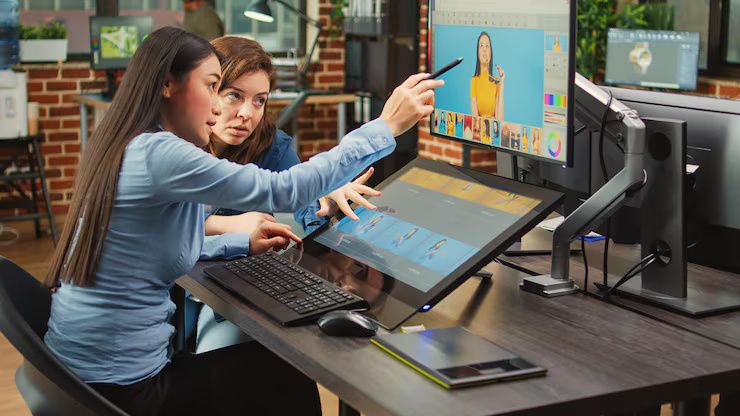Animation courses are educational programs that teach students how to bring images, characters, and scenes to life using visual storytelling. These courses may cover 2D animation, 3D animation, motion graphics, visual effects (VFX), and computer-generated imagery (CGI). Offered through online platforms, colleges, and technical schools, animation courses vary in length from short workshops to full-fledged degree programs.
Animation as a discipline blends artistic creativity with technology. Students learn drawing principles, storyboarding, timing, character design, and software tools like Adobe Animate, Blender, and Autodesk Maya. Animation is used in movies, television, gaming, advertising, e-learning, and more.

The demand for skilled animators has grown with the rise of digital media, OTT platforms, and gaming industries. As a result, animation courses are now a popular educational choice for creative individuals looking to build careers in digital content creation.
Importance – Why animation education is relevant today
Animation education plays a critical role in shaping modern storytelling and communication. Here's why it's important:
-
High industry demand: Streaming platforms, digital ads, e-learning content, and video games have all fueled demand for animation talent.
-
Diverse career paths: Students can explore jobs like character animator, storyboard artist, game designer, VFX specialist, or motion graphics designer.
-
Creative empowerment: Animation allows individuals to express complex ideas and emotions visually, often without the need for dialogue.
-
Global opportunities: Animation work can be done remotely, creating international freelance and employment prospects.
-
Tech-integrated learning: Modern animation education includes the use of AI, 3D modeling, and simulation, which makes it relevant across fields like healthcare, architecture, and marketing.
This field benefits both individual learners and industries that depend on engaging visual content to communicate and entertain.
Recent Updates – Trends and changes in animation education (2024–2025)
The animation world has seen a series of significant developments in the past year:
-
AI-assisted animation tools: Platforms like Runway ML and Adobe Firefly are being incorporated into course curricula for faster ideation and prototyping (2024).
-
Blended learning models: More institutions are combining online and offline instruction for flexible learning schedules.
-
Curriculum updates: Schools have begun including XR (Extended Reality) and game engine training using Unity and Unreal Engine to adapt to evolving industry requirements.
-
Increased certifications: Platforms such as Coursera, edX, and Udemy now offer specialized certification courses from reputed animation studios (e.g., Pixar and DreamWorks).
-
Cross-disciplinary learning: Animation courses are merging with UX design, coding, and digital storytelling to prepare multi-skilled professionals.
These changes reflect the need for dynamic, tech-savvy animators ready for diverse digital environments.
Laws or Policies – How regulations impact animation education
In most countries, there are no strict regulations specific to animation courses, but they are shaped by broader education and media policies:
-
India: The National Education Policy (NEP) 2020 emphasizes vocational skills and digital education, encouraging animation as part of technical learning.
-
USA: Federal student aid is available for accredited animation degree programs under Title IV.
-
UK: Government grants and student loans cover animation degrees under Creative Arts and Design.
-
Copyright laws: Animation students must understand copyright, fair use, and intellectual property rights as they create original content.
-
Content regulation: Animators must follow content guidelines under broadcasting and digital media laws if they aim to publish or sell animated work.
Staying compliant with IP and media policies ensures students learn ethical content creation and distribution.
Tools and Resources – Software, apps, and platforms for animation learners
Aspiring animators need access to tools and communities that support their learning and creativity. Here are some key resources:
Animation Software:
-
Adobe After Effects – for motion graphics and visual effects
-
Blender – open-source 3D animation suite (free)
-
Autodesk Maya – professional 3D animation and modeling
-
Toon Boom Harmony – industry-standard 2D animation software
-
Krita – for digital drawing and 2D frame-by-frame animation
Learning Platforms:
-
Coursera & edX – offer university-level animation courses
-
LinkedIn Learning – professional development courses in 2D/3D animation
-
CG Spectrum & Animation Mentor – specialized animation bootcamps
Communities and Inspiration:
-
ArtStation & Behance – for showcasing and networking
-
Reddit (r/animation, r/learnanimation) – for feedback and discussions
-
YouTube channels – like Alan Becker, Cartooning Club, and CG Geek
AI-Based Tools:
-
Runway ML – for AI-powered video and image animation
-
Kaiber & Pika Labs – transforming still images into animations
These tools help learners experiment, practice, and build strong portfolios.
FAQs
What qualifications do I need to take an animation course?
No formal qualifications are required for online beginner-level courses. However, for degree programs, most universities ask for a high school diploma or equivalent.
How long does it take to complete an animation course?
It depends on the type:
-
Short courses: 1–3 months
-
Diploma courses: 6–12 months
-
Degree programs: 3–4 years
Is a career in animation financially rewarding?
Yes. Entry-level animators can earn a moderate income, but with experience, salaries can rise significantly, especially in gaming and film sectors. Freelancing and international projects also offer strong earning potential.
Can I learn animation without drawing skills?
Yes, particularly for 3D and motion graphics roles. While drawing helps in 2D animation and concept design, many roles focus on modeling, rigging, or software operation.
Which is better—2D or 3D animation?
Both are valuable but serve different purposes. 2D is often used in traditional TV, explainer videos, and mobile games. 3D is dominant in movies, gaming, and VR applications.
Final thoughts
Animation courses offer a pathway to exciting, creative, and tech-forward careers. Whether you're an artist, designer, or developer, animation can help you tell visual stories that engage and inspire. With the expansion of online learning, AI tools, and digital platforms, now is a great time to explore animation education.
Whether you're a student, career switcher, or hobbyist, animation offers diverse opportunities and a vibrant community. By choosing the right tools and building the right skills, you can be part of this ever-evolving creative industry.
